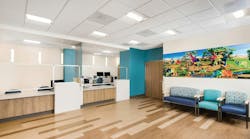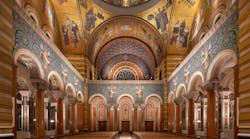For the project, an architectural firm headed by Frank Gehry was selected, even though he is better known for his exuberant designs of above-ground museums, performance halls and other public structures. He is reported to have said, “I’m ready to take on the project,” when he accepted at the age of 77.
On the creative team Gehry assembled was the lighting design firm of L’Observatoire International, headed by Hervé Descottes, who had directed an impressive list of interior and exterior installations for various exhibit and performance venues. “The lighting design modernizes the building for the twenty-first century with illumination that supports the most innovative modes of exhibiting its renowned collection,” said Descottes. “New lighting is in tandem with existing natural lighting to create a memorable experience for the visitor, balancing the grand scale of the museum through layers of light.”
The firm’s scope for the Philadelphia Museum’s Core Project included the building façade and entrances, new and renovated public spaces, and circulation and exhibition spaces. While improvements were made throughout the museum, this article will focus on four major areas—the Vaulted Walkway, Williams Forum, Forum Gallery and Lenfest Hall.
Suspended from the arched ceilings is a custom Light Bar. Descottes describes it as a linear element which integrates all lighting for the space. Uplights accentuate the singular overhead expanse of the tiled vaults, while downlights guide visitors along the remarkable corridor. Between the downlights, track lights can be inserted for highlighting of art exhibits.







